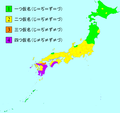Iteration marks are characters or punctuation marks that represent a duplicated character or word. In Chinese, 𠄠 or U+16FE3 𖿣 OLD CHINESE ITERATION...
20 KB (2,153 words) - 18:46, 4 May 2025
to the previous source Iteration mark – Character or punctuation mark used to represent a duplicated character or word Ditto mark. Oxford Dictionaries....
8 KB (717 words) - 16:51, 26 May 2025
called "internal iteration" because its code fully executes within the context of the iterable object (that controls all aspects of iteration), and the programmer...
49 KB (5,773 words) - 11:58, 11 May 2025
List of Japanese typographic symbols (redirect from Geta mark)
Katakana Man'yōgana Sōgana Gojūon Typographic symbols Japanese punctuation Iteration mark Uses Syllabograms Furigana Okurigana Braille Transliteration Rōmaji...
19 KB (97 words) - 12:52, 6 September 2024
Dakuten and handakuten (redirect from Voicing mark)
identical to writing the kana out in full. A longer, multi-character iteration mark called the kunojiten (〱), only used in vertical writing, may also have...
17 KB (1,796 words) - 06:25, 10 April 2025
Japanese punctuation (section Part alternation mark)
Japanese punctuation marks, see the Japanese punctuation marks category of words in Wiktionary, the free dictionary. Iteration mark Japanese typographic...
20 KB (1,925 words) - 01:05, 19 February 2025
ねぇ, nee). Plain (clear) and voiced iteration marks are written in hiragana as ゝ and ゞ, respectively. These marks are rarely used nowadays. The following...
52 KB (4,201 words) - 13:36, 1 June 2025
U+309C. U+309D is the hiragana iteration mark, used to repeat a previous hiragana. U+309E is the voiced hiragana iteration mark, which stands in for the previous...
33 KB (3,128 words) - 03:20, 6 May 2025
Japanese words written in katakana use the elongation mark, too. Standard and voiced iteration marks are written in katakana as ヽ and ヾ, respectively. Small...
57 KB (4,676 words) - 03:13, 17 May 2025
notification prescribes (通則6) the okurigana usage 次々 (iteration mark), but 休み休み (no iteration mark if okurigana are present). The 1981 Cabinet notification...
36 KB (4,728 words) - 20:40, 28 March 2025
system Genkō yōshi (graph paper for writing Japanese) Iteration mark (Japanese duplication marks) Japanese Braille Japanese language and computers Japanese...
39 KB (4,456 words) - 21:03, 2 June 2025
long history. The iteration mark (々) is used to indicate that the preceding kanji is to be repeated, functioning similarly to a ditto mark in English. It...
91 KB (9,169 words) - 09:01, 17 May 2025
Katakana Man'yōgana Sōgana Gojūon Typographic symbols Japanese punctuation Iteration mark Uses Syllabograms Furigana Okurigana Braille Transliteration Rōmaji...
7 KB (854 words) - 05:56, 15 December 2024
sokuon appears as a tsu reduced in size: The main use of the sokuon is to mark a geminate consonant, which is represented in most romanization systems by...
12 KB (1,129 words) - 20:47, 2 June 2025
Chōonpu (redirect from Katakana-Hiragana Prolonged Sound Mark)
(長音記号), onbiki (音引き), bōbiki (棒引き), or Katakana-Hiragana Prolonged Sound Mark by the Unicode Consortium, is a Japanese symbol that indicates a chōon, or...
7 KB (558 words) - 23:54, 29 May 2025
Katakana Man'yōgana Sōgana Gojūon Typographic symbols Japanese punctuation Iteration mark Uses Syllabograms Furigana Okurigana Braille Transliteration Rōmaji...
9 KB (861 words) - 13:44, 6 November 2024
Japanese, formally written 担担麺, as in Chinese, but often written with an iteration mark as 担々麺, or with 坦 instead of 担. It is sometimes considered a form of...
8 KB (727 words) - 00:34, 28 May 2025
include: 々, the kanji iteration mark, from 仝, a variant of 同; 〻, the vertical form, from 二; the hiragana and katakana iteration marks, ゝ and ヽ, generic strokes;...
17 KB (1,868 words) - 14:43, 31 December 2024
mark (a superscript arc). Counting syllables with this diacritic, the script represents 1,164 syllables. In addition, there is a syllable iteration mark...
175 KB (2,359 words) - 06:11, 4 May 2025
Tangut were added to the Tangut Components block. An iteration mark, U+16FE0 𖿠 TANGUT ITERATION MARK, was included in the Ideographic Symbols and Punctuation...
13 KB (1,246 words) - 12:59, 30 May 2025
For example, U+A015 ꀕ YI SYLLABLE WU has the formal alias YI SYLLABLE ITERATION MARK, and U+FE18 ︘ PRESENTATION FORM FOR VERTICAL RIGHT WHITE LENTICULAR...
111 KB (11,532 words) - 02:26, 3 June 2025
portal Language portal List of ISO romanizations Hadamitzky, Wolfgang; Spahn, Mark (October 2005). "Romanization systems". Wolfgang Hadamitzky: Japan-related...
49 KB (3,537 words) - 08:29, 25 May 2025
Katakana Man'yōgana Sōgana Gojūon Typographic symbols Japanese punctuation Iteration mark Uses Syllabograms Furigana Okurigana Braille Transliteration Rōmaji...
13 KB (1,003 words) - 19:36, 4 May 2025
character forms (yōon and sokuon), which are used in regular orthography to mark such things as gemination and palatalization, is often not made in furigana:...
24 KB (2,876 words) - 20:01, 17 May 2025
"sometimes, from time to time". The iteration mark 々 can be used to indicate reduplication, although in Chinese the iteration mark is no longer used in standard...
88 KB (9,193 words) - 07:24, 2 June 2025
very similar to how Chinese and Japanese use their iteration marker 々. Japanese uses 々 as an iteration marker, so, for example, 人人 (hitobito) would be written...
46 KB (4,365 words) - 00:19, 24 May 2025
among women in Jiangyong County in Hunan province of southern China. An iteration mark for Nüshu is encoded in the Ideographic Symbols and Punctuation block...
15 KB (182 words) - 16:07, 26 July 2024
396 syllabograms are defined. In addition, an iteration mark for Nüshu U+16FE1 𖿡 NUSHU ITERATION MARK is in the Ideographic Symbols and Punctuation block...
24 KB (2,932 words) - 04:23, 25 May 2025
Katakana Man'yōgana Sōgana Gojūon Typographic symbols Japanese punctuation Iteration mark Uses Syllabograms Furigana Okurigana Braille Transliteration Rōmaji...
5 KB (399 words) - 00:13, 5 May 2025
sometimes by duplication (e.g. 人人, hitobito, usually written with an iteration mark as 人々). Words for people are usually understood as singular. Thus Tanaka-san...
95 KB (10,888 words) - 21:53, 2 June 2025













